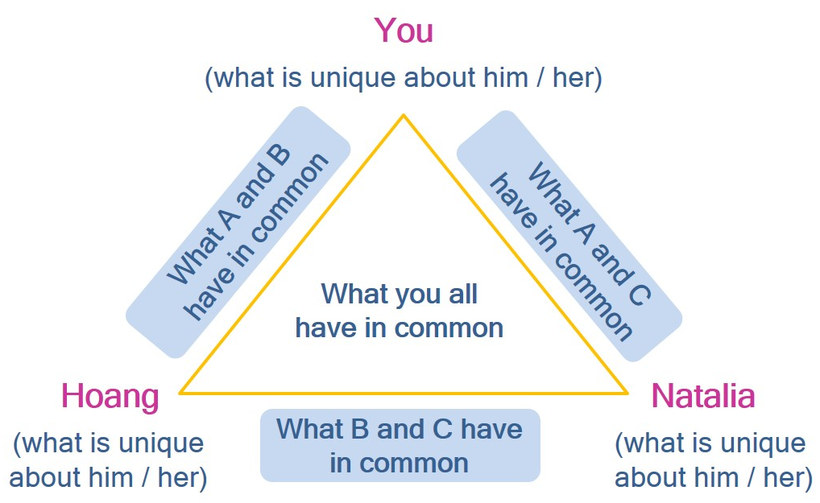Working in VITeams poses challenges with regard to handling computer based communication technology, coping with the absence or reduced face-to-face interaction, communicating using asynchronous technology, developing an e-culture and collaborating with diverse team members. And reaching the goals set, working well together as well as developing satisfying relationships requires a range of interdependent competences. Four areas appear to be of particular relevance in this context and converge on similar challenges: Openness, communication, culture-reflexive knowledge and negotiating culture. In the following the meaning of these as well as sub-competences are being explained, examples are given and subsequently an activity offered to assess your achievements with regard to the specific competence.
***
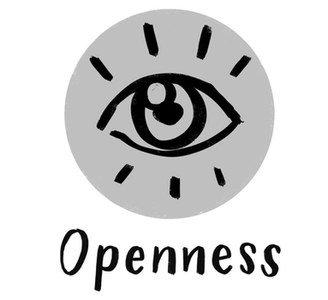
Openness in the sense of being ready to explore new situations and feeling comfortable in unfamiliar and at times highly complex situations is surely a valuable trait to address intercultural encounters constructively. Openness encompasses New Thinking and a Welcoming Attitude, which can be understood as the readiness to initiate relationships with new people and those who may be very different for example with regard to their different backgrounds, experiences and behaviours. If we want to develop a common ground, Acceptance is also important, which refers to accepting behaviour that may be very different from our own or even be in conflict with our own sense of best practices.
An attitude of openness is especially important when we work in virtual environments. The willingness to regularly deal with new communication technologies and to develop a virtual media competency is a key prerequisite for an effective and constructive collaboration of a virtual team.
Openness also plays a vital role in building trust and developing strong relationships with other members of a virtual team. Virtual communication is often limited because of a lack of non-verbal communication such as gestures and facial expressions or of rare opportunities for informal talks amongst other things. This might hinder the development of understanding and empathy for the different opinions and working styles in a virtual team. Being prepared to accept these limitations and to find new ways to build up team spirit and working relationships is thus a central competence for successfully working in virtual contexts.
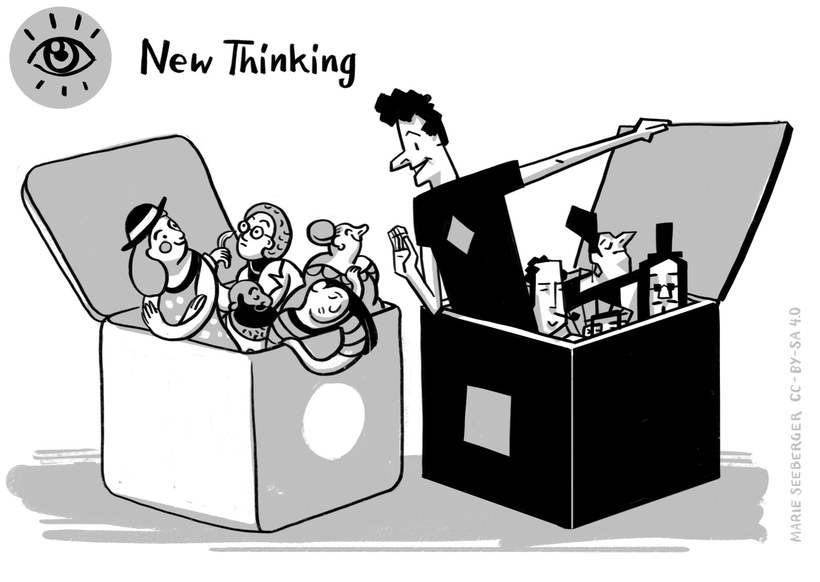
Meaning
People who have the competency of New Thinking feel passionate about following up with new ideas or developments. These are people who have a natural curiosity and like to venture into new and unfamiliar fields. They also like to view things from different perspectives, challenge established facts, and like to get “to the bottom” of things by learning more about the background and connecting the dots. Using their curiosity as well as their natural sense of creativity they like to find “out of the box” solutions for established challenges.
The ability to rethink work routines and the willingness to explore new ways of working together is especially important for members of intercultural virtual teams. Given the fact that these teams often consist of very diverse people with different backgrounds and experiences it is critical that all team members are able to reflect their own thinking and behaviour as well as to accept different perspectives on how the work should be done and on how best they can make use of the resources in the team. In particular, these competences are required in virtual settings when the team members do not have the opportunity to regularly meet in person.
The willingness to behave flexibly and to analyse issues from different angles without judgement allows a fresh look at organisational or strategic challenges and often provides chances for finding innovative, non-expected solutions for them.
Example
Anne is working in a global pharmaceutical company and leads an international research team. In the last years her team has developed an efficient working routine with regular virtual team meetings. All team members have access to a VPN based shared drive and they can use a couple of collaboration tools when they are working together for a project. Now Anne has just hired Malia and Faki, two postgraduates from Uganda with excellent skills that her team urgently needs to have.
The challenge: Due to the poor quality of their internet connection Malia and Faki have to join the team meetings without camera and often without sound. Also it is not possible for them to get access to the VPN shared drive which heavily impairs the collaboration with their team colleagues.
In a team meeting Anne therefore asks her team members to develop new ideas on how they could improve their cooperation and exchange of information with the two new colleagues.
The team agrees on the following steps: Each team member will send important documents and research results via e-mail to Malia and Faki. In team meetings they will write their thoughts and ideas in the chat while the team is waiting for their input. Every two weeks the team will meet in an audioconference. In addition to the shared drive the team will use a cloud based storage platform.
Although these new working processes are more time consuming, the entire team is pleased with the results of the meeting as they allow Malia and Faki to contribute their insights and to build up their relations with their new colleagues.
Activity: Changing your work routines
Think about a situation in a virtual team you are (or have been) part of where you had to adapt your work routines (e.g. use a new IT software, switch to another language, work with new colleagues). What was the main challenge for you? What has helped you to come up with new ideas? Which competences are important to successfully manage this change? How could you develop them further? Note down your ideas and strategies for New Thinking in your learning journal.
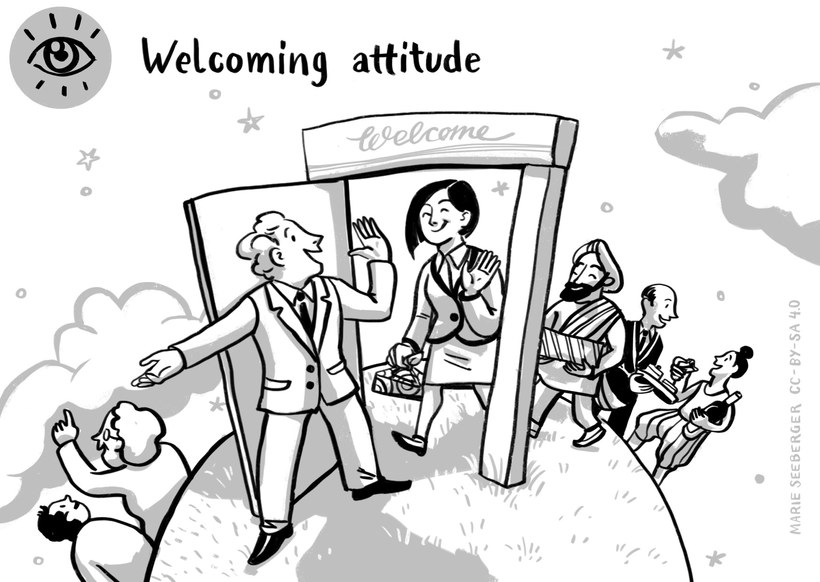
Meaning
People with a Welcoming Attitude like to get to know to and learn from individuals that might have different thoughts or backgrounds compared to their own (e.g. age, gender, educational background, personal interests, professional experiences). They find it interesting to exchange thoughts with people that have very different perspectives. Besides, these people find it well within their comfort zones to take the initiative and approach people that might dress, speak or behave differently than themselves or also speak another language. They also find it fulfilling to help those who join a group or a team and look for orientation.
For members of virtual intercultural teams, a welcoming attitude is especially important as communication and cooperation mainly happen in a virtual environment. In this setting team members rarely or never have the chance to meet in person and are obliged to use technology based communication tools. As important communication channels such as gestures and facial expressions are limited in this environment each team member has to find other ways to show his or her welcoming attitude e.g. through asking, offering support during the start phase, sharing personal information.
The ongoing development of this competence allows virtual teams to integrate new team members very quickly and to develop satisfying and effective work relationships.
Example
Cristina has accepted a new position in an international pharmaceutical company. Today she is very excited as she will meet her new team colleagues in a virtual meeting for the first time. When she enters the meeting room she receives a very warm welcome from her team lead and all team members. All of them have prepared a written personal profile in which they name their professional experiences but also their private interests e.g .hobbies, preferred music styles and book preferences etc. Cristina is happy to hear that two team members share her passion for singing while another colleague loves yoga as she does. Prior to the meeting her team lead Svenja has sent her a “surprise package” she is now allowed to open. Inside Cristina finds some delicious cookies and chocolate bars which all are vegan. She mentioned this preference in the informal part of the job interview but is surprised that Svenja remembered that detail. During the meeting the team members explain their individual responsibilities and current work tasks to Cristina and invite her to ask all questions she might have. In addition to the regular team meetings Cristina will also have regular meetings with her team lead who will explain working and communication processes so that Cristina will quickly come up to speed. After the meeting Cristina is perfectly happy as she feels herself appreciated and welcomed. She is convinced that the cooperation with her new colleagues will work very well.
Activity: Joining a team (1)
Remember your thoughts and feelings when you joined a virtual team for the first time, either in your professional or your private life. What did you do differently in comparison to a personal meeting? How did you behave in this situation and how did your new teammates? Do you also remember some inner hurdles and hesitations you might have had? What helped you to get in contact with your colleagues? What have they done to welcome you as a new team member?
Note down the three main lessons learned from this experience in your learning journal. In addition write a short commentary as to what was helpful in dealing with the situation well and what you would do differently the next time. The strategy you used is a valuable resource to remember when you become part of a new virtual team again or when new members join a team you are already part of.
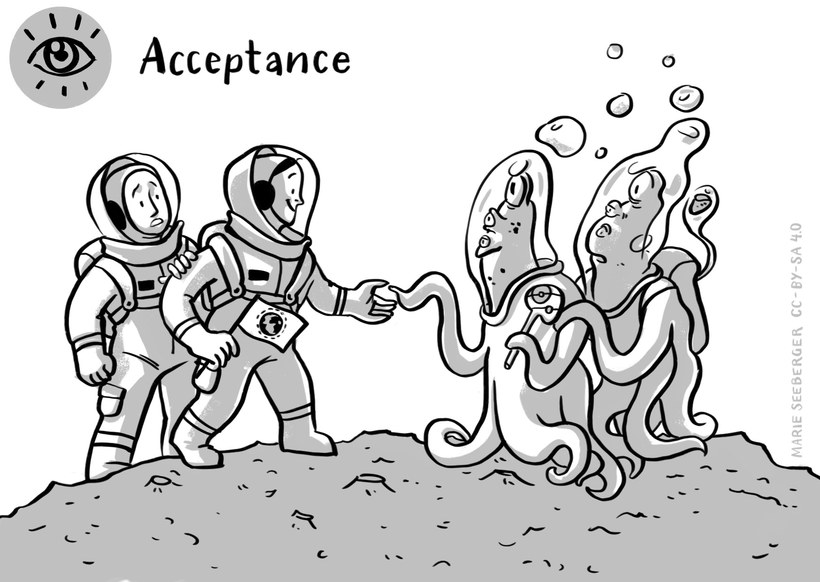
Meaning
In short, to have a high level of Acceptance means to avoid judgments about other people´s behaviours, especially if these do not conform to our expectations. Especially when we work in intercultural virtual teams the chance is high that we encounter behaviour that might be seen as disrespectful from our personal experience and perspective. In this case we need to try to understand the background rather than to judge too quickly. Because a quick judgment can hinder us from understanding other possible reasons behind other people's behaviour, to be open-minded enables us to see the bigger picture. However, Acceptance is about more than tolerance and understanding our counterparts. It is also the awareness that other work practices can expand our own horizon and also increase the team performance.
It does not, however, mean that we need to like or copy any other behaviour from other people. All of us have limits to our level of acceptance, which are often deeply rooted in our value system. There are several ways to deal with these limits in an “accepting” way. As mentioned, we can see them as an opportunity to learn and grow from them. Another way may be to tolerate these differences. That means, if a behaviour or concept might be very difficult for us to accept, it could also be a viable strategy to try avoid the confrontation and to withhold our judgement. The prerequisite of acceptance is to respect an approach that differs from my own.
Example
Brian is used to start his working day very early, usually at 7am. Weekly team meetings with his colleagues from other branches are scheduled at 8:30am. Two months ago two new team members have been hired. Both of them joined the team meeting several times too late and Brian is increasingly getting upset about this behaviour. Why are his colleagues so impolite? Why do they let the whole team wait for them? Don´t they know that it is a waste of time for their colleagues? Do they even care about that?
Brian decides to discuss this issue with his team lead Linda. She fully understands his anger but also explains that both of his new colleagues have good reasons for their behaviour: Marcus has to drive his two children to school. Classes start at 8am making it very difficult for Marcus to join the team meetings in time. Marisa is a “late bird”, she loves to work late at night so it really is a challenge for her to get up early in the morning. Linda also refers to the fact that both Linda and Marcus are still available for customer requests in the late afternoon when the rest of team has already left the office. Thus Linda could extend the service times of the team by two hours.
After the conversation Brian knows more about the motivation behind the behaviour of his colleagues. He, too, would have good reasons for joining the team meetings later or not at all at times but decided make the meetings a priority. It is difficult for him to accept but he decides to deal with it.
Activity: Dealing with irritating behaviour
If you think about your experiences in a virtual team: Which behaviour of one of your colleagues did you perceive as impolite, rude, disturbing or annoying? Which thoughts and strategies have helped you to overcome your negative emotions? Reach out to a friend or a colleague and ask them how they cope with a behaviour they cannot understand at all.
Note your answers in your learning journal.
***
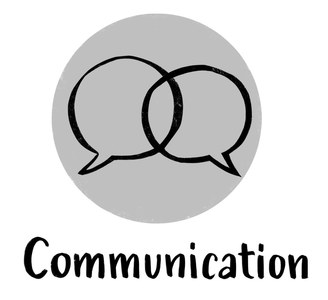
Another set of competences is linked to Communication and thus the ability to absorb, share and understand information considering the sender’s perspective and respond in a way that is comprehensible from the receiver’s point of view. In short, it is the ability to communicate in a way that minimizes the potential for misunderstandings. It is thus not surprising that ensuring the Co-construction of Meaning is an important aspect in this context. Being able to establish and maintain trust by Exposing Positive Intentions is another valuable trait to support the development of a common ground. Knowing about different communication styles and interpretations and usage of non-verbal signals is the basis for the ability to be receptive to Communication Styles and Non-verbal Signs. Such an ability greatly supports understanding and the co-creation of meaning.
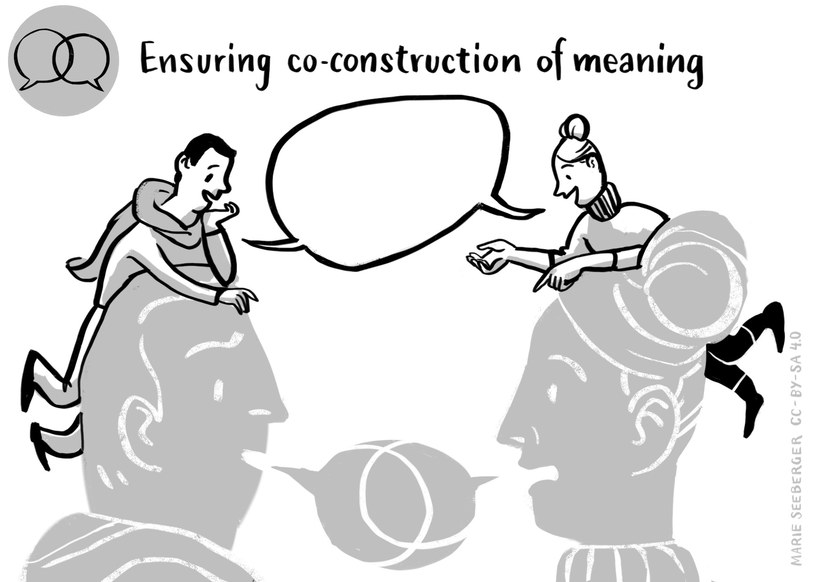
Meaning
Patterns of meaning and interpretations at times collide in intercultural situations because very often we use terms which mean different things to different people. This especially applies to VITeams as team members often have a different functional knowledge due to their professional qualifications or speak different languages which might also include a different understanding of the concept of a specific term. Also new team members regularly have to learn the professional and technical language of their teams as well as the technical terms that are relevant for their work.
As a consequence, all team members should be confident in Co-construction of Meaning and place emphasis on communicating and dialoguing with all people involved. They make sure that everyone involved has an understanding of how something is meant. The process behind this may or may not lead to the generation of a common meaning for a specific term or concept. Most important is that all people involved have a thorough understanding of how something is understood by a person.
Example
Li-Ming is a research manager in an international consulting company. She has just finished a 1to1 with Carlos, a new hired research specialist. Carlos has told her that he really was confused after having read the agenda for the next (and his first) team meeting. So Li-Ming re-reads the agenda trying to assume the perspective of a new team member:
- Top 1 Welcome round for Carlos
- Top 2 Reports from CRM, F&A, BPS
- Top 3 List of new WBS
- Top 4 Postings in the KM db
- Top 5 New global responsibilities in Industries + SL after "RapidChange 5.0"
Now she can clearly understand Carlos confusion about the technical language and the abbreviations used in the meeting invitation. She decides to put the following measures in place in order to facilitate the initial training period of new hired team members:
Her team will create a glossary explaining the most important abbreviations and technical terms.
Li-Ming will prepare a global organisation chart showing the most important contact persons for her team.
For every new team member, she will nominate a personal mentor who will closely work with his or her mentee and answer all upcoming questions during the orientation phase.
Activity: Joining a team (2)
If you think back on a situation when you joined a (virtual) team in your professional or private life: What was important for you in order to quickly become acquainted with colleagues, responsibilities, working processes etc.? What might have confused you?
In the light of your personal experiences: What do you think should be done if new colleagues will enter a team you are already part of? What could you do yourself? Note down your ideas in your learning journal.
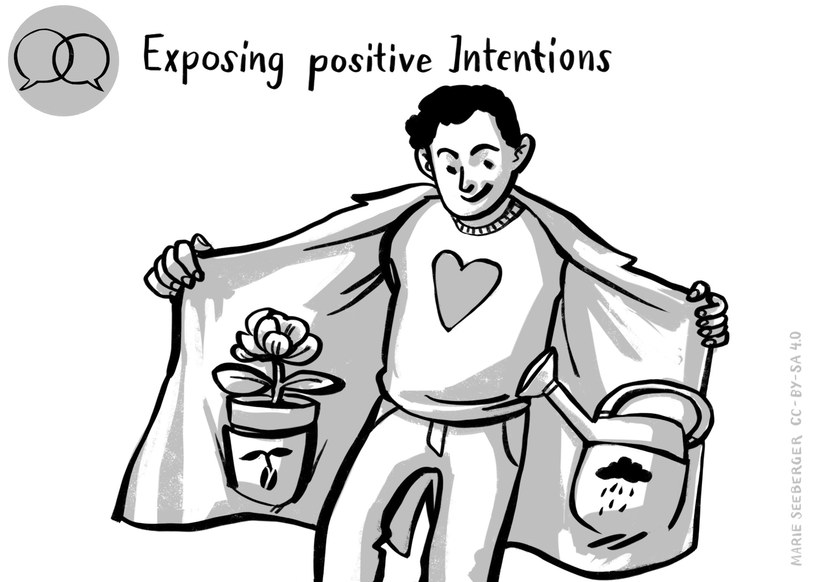
Meaning
Having an open mind when working with people of different backgrounds and perspectives is not always enough. To know how to Expose our Positive Intentions means that you are also able to deliver this attitude in a way that it is being understood by your colleagues. Team members with this competency know how to deliver their message in a clear and transparent context, but also consider the communicative needs of their counterparts. It especially means to be clear about your intentions, wishes and expectations, and that you are sure to display your position in a constructive and non-threatening way.
Example
Zamil has a new colleague who just joined his marketing team some weeks ago. Unfortunately, Zamil sees that his new colleague has not been meeting any of the set deadlines so far. Also, whenever she finally sends the information needed, Zamil sees that it often is not the data they agreed on to be delivered. The next time they meet, Zamil makes an extra effort to small-talk with her, using phatic expressions to ensure that a personal bridge is developing between them. He transparently highlights his needs but also emphasizes his offer for support and their common goals for the project.
His colleague is now clear about what Zamil needs from her and does not feel threatened by his feedback.
Activity: Dealing with a touchy topic
Write down in your learning journal the conversation Zamil might have had with his colleague (only Zamil's part). What could Zamil have said (quote!) to express his positive intentions? Note down the beginning of the conversation, and how he cultivates the relationship. Also write down how he approaches the touchy topic by showing his positive intentions.
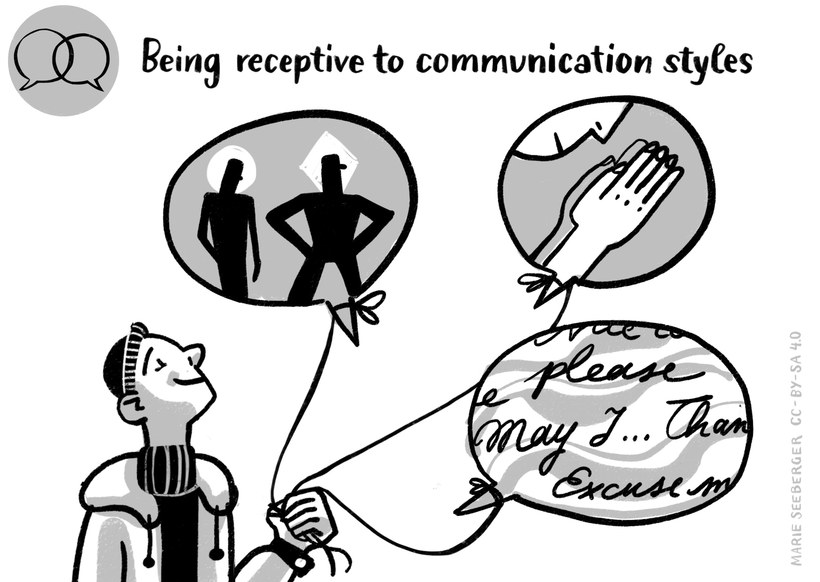
Meaning
While Exposing Positive Intentions enables us to make ourselves understood in a way that displays our open-mindedness, Being Receptive means that we are also open to the communication needs of our team colleagues. It means we not only have an open mind but also know how to transport this attitude to our communication partners. We know which questions to ask in order to display that we do not seek to convince, but rather to understand our counterparts. We are sensitive to possible signs, for example, body language and mimics, and can correctly understand the intentions in high- or low-context messages. This might be a challenge in virtual teams as the communication is mainly limited to phone call, chats and web conferences. In this environment we have to be very attentive and mindful in order to react to verbal or nonverbal signs adequately and appreciative.
Example
Today Julie hosts the weekly online meeting of her team. In the course of their lively discussions she observes that Marcus, one of her team members behaves slightly different than in other meetings: Usually he is very engaged in every discussion. Today he explains his thoughts about various topics but his intonation seems to be a bit flat. From time to time he closes his eyes, his face is pale. Julie is not sure how she should interpret her observations. So after the meeting she calls Marcus, shares her observations with him and asks if everything is alright. Marcus is quite surprised that she has noticed these small differences in his behaviour. He then tells her that his wife and his daughter are ill so that he hadn´t slept the night before. Julie spontaneously offers him a couple of days off so that he will be able to take care of his family and to take over some of his projects in this time. Marcus is really grateful for this offer.
Activity: The interaction between the team lead and the employees
Please watch the Youtube video "How Teams Can Meaningfully Connect Remotely" by Simon Sinek, starting from minute 2:15 until you reach minute 8:15, and have a look at the interaction between the team lead and the employees. When doing so, pay particular attention to the non- and para-verbal communication of all participants. Choose four spots or situations and analyse and interpret them from the perspective of the team lead. It may be helpful to either describe them or take a screen shot to indicate which one you are referring to.
In a second step think about how you, as a team lead, would react to accommodate the needs of your team members.
Which of the ideas present in the video would help your team to communicate better? Choose two ideas and argue why you would be ready to integrate them into your teamwork.
Put your answers in the learning journal.
***
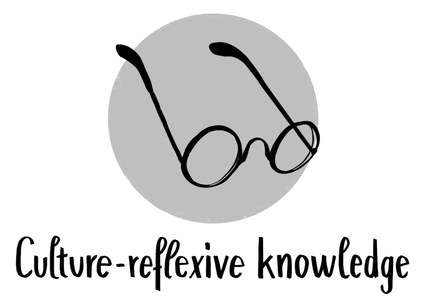
The next set of competences considered in this session relate to a Culture-reflexive Knowledge. This encompasses more than referring to knowledge such as “this is how things are being done around here”. Reflexive knowledge is knowledge based on conscious reflection and reasoning. It follows the rules of rationality and the knowledge that there is more than one way of doing things right. Reflexivity is thus understood as the ability to step outside one’s own frame of reference and enhancing one’s understanding of reality through the eyes of the communicators and thus in their own terms.
Developing culture-reflective knowledge thus requires the ability to Reflect Perspectives which refers to the ability of viewing things from different points of views and to consider issues in their relations, interdependencies and relative importance.
Another important aspect of culture-reflexive knowledge refers to being Sensitive to Context. This entails to acknowledge that context has an important influence on an interaction. And that an interaction not only takes place in a specific physical context (e.g. online, office, at the doctor) and is thus influenced by environmental conditions but that the people themselves are enmeshed in a personal context (e.g. strict order from their superior, organizational culture, immediate social context) which guides their encounters.
The last aspect to be considered is the Awareness of Global Social Positioning. This refers to given asymmetries in encounters as it is important to acknowledge that there is a limit to changing perspectives. This is so because there are experiences we cannot share and perspectives we cannot take. For example, a “White” person can hardly anticipate how a Person of Colour (PoC) experiences a world where whiteness is the privilege. A person able to walk will not have the same perspective on side-walks and footbridges as someone who is reliant on a wheelchair in a world of pedestrians with two healthy legs. We therefore are required to meet the continuous challenge of balancing different approaches to the world and to overcoming the dominance of selective perspectives.
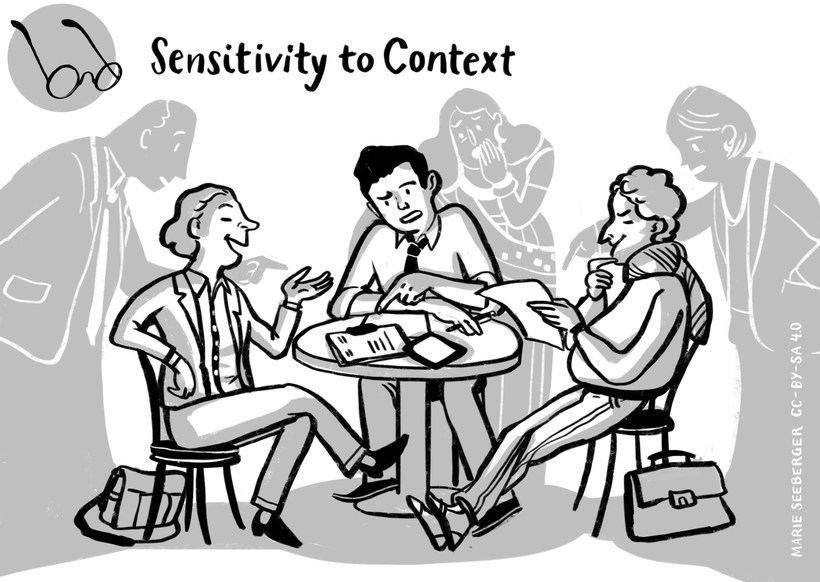
Meaning
We all have a tendency to overemphasize personal characteristics when judging a person's behaviour and ignore situational factors. In social psychology this is called "fundamental attribution error". People who are Sensitive to Context place emphasis on inquiring, sensing and understanding the influence the context has on the interaction and the communication. The overall context relates to the environment, the setting and the location in which an interaction takes place or communication is practiced. Sensitivity to context also includes considering the immediate context of the people involved. This can include the organizational context they are in, social rules and mutual expectations that guide communication, interdependencies in relationships as well as aspects referring to the interpersonal history and type of relationship which exists between the people involved (so the counterpart is the basis for the reaction). Other contexts can be the emotional and mental well-being, a region, things that just happened shortly before the incident etc. People sensitive to contexts are able to sense possible expectations of language and behaviour related to the overall and personal environment.
Trying to see this perspective can prevent us from becoming agitated, and thus start a negative communication circle. It also keeps us from feeling disrespected or frustrated based on the reasons of misunderstanding.
Example
Luis is part of a virtual software development team which he feels really pleasant to work with. However, more recently he noticed that Raoul, his Portuguese team member, appears to be absent minded, stressed out and at times joins their meetings ill prepared. Luis decides to pick up the phone and enquire about Raoul and his situation. He learns that Raoul’s father in law is hospitalised and that Raoul’s wife is needed to take care of him because her father finds it difficult to cope with the situation in hospital. As the hospital is some 200 kms away from their home, his wife left him to take care of their 5-year-old twins. As a consequence, Raoul tries to work from home but finds it difficult to concentrate and on top has to juggle work, the care for his children and the household. Luis is glad he phoned and quickly feels his anger vanishing. Knowing about the circumstances and the context in which Raoul works makes it a lot easier for him to be empathic and they both agree that Raoul should mention his current situation in their next meeting so that, as a team, they can try and find a way of supporting him.
Activity: Contextual issues
Think about one person you worked with recently and draw an image of that person indicating the many contexts he or she may be involved in. Do the same for yourself and think about your own contextual issues and how they influence your work day and work processes. Note down three examples of how your contextual issues influence your work and how context is likely to influence your co-worker or team members.
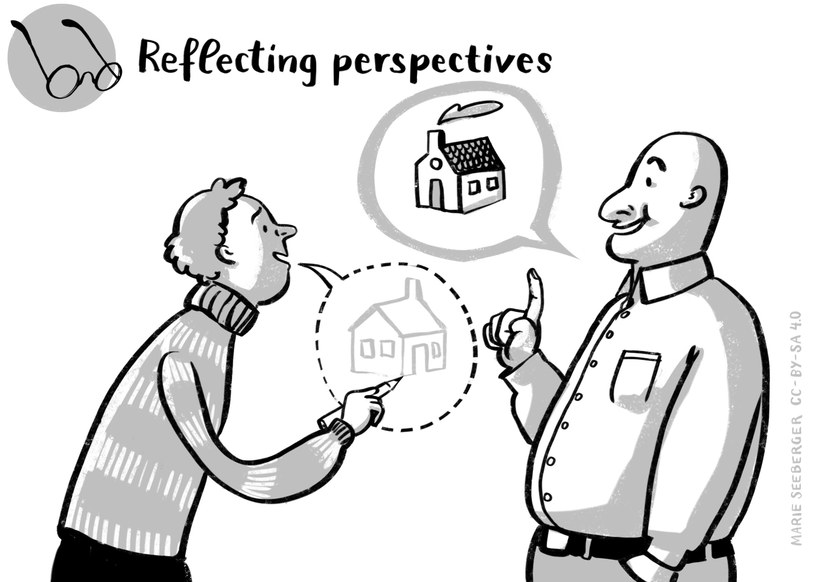
Meaning
The competence of Reflecting Perspectives is essential in a virtual diverse media mediated working and life world. Hardly any perspective is from the same position as team members find themselves in totally different situations. Here are some examples:
A father of two toddlers in the home office relies on special hours for the team meetings so that he can participate. He thus considers meeting hours through this perspective.
A colleague in Delhi working with a European team is the only one in a different time zone than European standard time where most of the team members orient to. Also, she is the only native speaker of English. However, she was never outside of India and no one from the team members have ever been to India or know enough about the diversity of languages and cultures.
How does a situation look from the perspective of a person who needs hearing aid and devices in online and present meetings?
How is virtual work for someone who prefers to meet in person to the ones who love to use technical devices? Many examples and perspectives could be added.
Take any situation, we never have the whole picture, we only have one or some perspectives that we understand as the whole view. Acknowledging this and reflecting our perspectives on purpose we raise our awareness that there are more approaches than those that we might have in mind, and that there is not just one “truth” and reality. Reflecting perspectives means keeping in mind different cultural orientations and values but also numerous other perspectives at times difficult to anticipate.
A team leader as well as team members need to anticipate the others’ potential perspective and plan for how they might receive information and react to how content is delivered. A culturally competent team leader and member would consider language, gender, culture, and a multitude of other factors. Reflecting perspectives is a critical competency to master in general but particularly in virtual settings due to the missing non-verbal cues many depend on for deciphering a message.
Example
Pablo recently participated in a workshop to improve communication in virtual teams. The workshop started with two examples of e-mails and Pablo was asked to analyse them considering the four-side model by Schulz von Thun. This model is based on the assumption that every message contains content and relational facets as well as a request and it also reveals something about the person who sends the message.
This meant Pablo was asked to analyse the mails considering
- the content or actual facts conveyed,
- what the message may reveal about the relationship between the sender and the receiver,
- what the message may say about the sender, and
- what the sender wants the receiver to do.
The two e-mails read as follows:
E-mail 1:
Minutes of meeting required by tomorrow morning, thanks Dave
E-mail 2:
Dear Roberto,
How did you perceive the meeting? Sorry it took so long and I knew that you were aiming at heading home real early. How is your cold, any better? Following up on the meeting, I am wondering whether you could possibly send me the minutes by tomorrow so that I can distribute them among participants?
Best regards, Madeira
Comparing the two e-mails it kind of hit Pablo that he actually has a tendency to write short and very factual oriented e-mails and that in doing so he may not show any of the appreciation he has for his team members. He is especially thinking of his two team members who always write elaborate mails inquiring about him and his family and that they may perceive the relationship with him as very distant and may be even cold. He also thinks that his e-mails may reveal and be perceived as if he has no interest in his team on a personal level.
During his next social call with his team members Pablo told them about the workshop and his findings. He happily took note of the fact that his thinking was right about his two team members who empathically nodded during his speech. He was also surprised how his disclosures positively influenced and helped to improve team spirits and relationships showing the positive influence of reflecting perspectives can have.
Activity: Changing perspectives
The next time you have an important message for your team members, carry out the following exercise.
Ask yourself: What is it I want to convey?
- in terms of information and factual issues (factual level)
- with regard to the relationship with those who are going to listen to me (relationship level)
- with regard to myself, e.g. that I am stressed (self-revealing level), and
- with regard to what I want them to do (appeal level)
In a second step put yourself into the shoes of a team member and think about how he/she may perceive the message content.
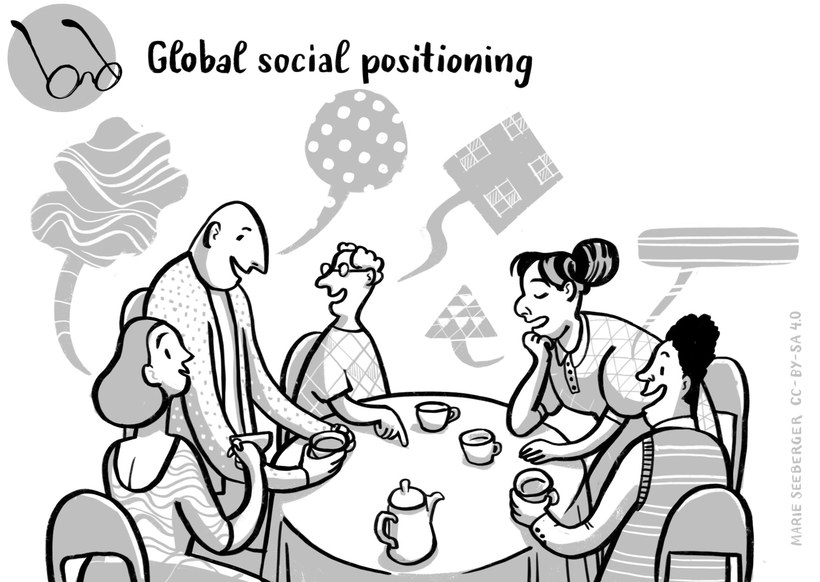
Meaning
Persons who are aware of Global Social Positioning take macro influences of an encounter into consideration and incorporate pre-distributed privileges. Whenever people meet there is one thing we have in common: we are all human beings with own dignity, but there is diversity in the way that societies and cultures judge the value of attributes like gender, age, physical abilities, religion or spiritual beliefs or any worldview, wealth, educational background, sexual orientation, parental status , language skills and many more factors. These judgments have huge influences regarding our chances in life. Some differences are not only prejudged by most societies, also living conditions are oriented towards a specific normality that discriminate or excludes variances. Hence, pre-distributed privileges and chances for career and success in life are a result. Keeping this in mind, we might be easier able to accept a perspective we do not share and balance powerful differences. It is a practice to deconstruct power asymmetries and acknowledge collective experiences like living in a diaspora.
Example
Diane, a UK citizen, worked as a development consultant and had recently joined a project team involving experts from different parts of the world. The team members were quite diverse in terms of gender, work experience, level of international expertise and country of origins. It was decided to have a four-day kick-off conference in Kenia to facilitate traveling for participants from East Africa. Everybody was excited to meet face-to-face for the first time. By the early evening, everybody had arrived and the whole group enjoyed their dinner. After a pleasant meal, Diana decided to go to the meeting room, write the flipcharts, have the agenda printed out and have everything set for their meeting the next morning. When she looked outside of the window, she saw a minivan pulling up at the hotel entrance and a happy crowd waiting to be taken to town. It was then that she recalled hearing conference participants talking about the need to leave the conference venue in order to explore and enjoy the evening in town. And here they were happily chatting along and hopping on the minivan. Nobody had asked her to join them and Diane felt a disappointment creeping in on her. Why was she left out? Didn’t she organise all this so that they could become a team? Was it because she was from the Global North and the others from the Global South? She decided to let go for the time being but on the second day proposed to discuss the topic of global hierarchies and how these may impact their team work. She was surprised about the comments made. A Namibian participant complained about the lack of transparency of project funding and suspected that this was due to the vast and unfair difference in daily allowances Diane coming from the UK and the rest of the team coming from different countries in Africa received. The point a participant from South Africa made was linked to what she perceived as ‘knowledge hierarchy’. She described this as a practice employed by Diane to have everything prepared, the agenda but also the content to be discussed with the result that there was little opportunity for the rest of the group to contribute substantially. She complained that they were not being involved right from the start although Diane repeatedly said that she wants them to develop into a team. Diane was baffled to realise how much the global North/South divide influenced their perception and interpretation of what was happening and was glad to have brought up the issue. That night they all went to town, explored the local bars and encouraged each other to be more open in their communication and also in revealing their perceptions.
Brian (Mongolian, homosexual) studies International Management, a Master program where his fellow students come from many different countries. Together with Marie, Debbie and Marcus he works on a paper addressing issues of diversity and its impact on management. One day, Marie listens in to a conversation among other class mates about Brian being homosexual. Marie realises that she knows very little about homosexuality itself, how it influences one's life being around a majority who has the support of a dominant sexual culture nor is she sure about how to approach the issue and how to talk about it. But listening to the rather stereotypical comments of her class mates she also feels the urge to ask Brian about his sexual orientation, how he would position himself and try to capture the world from his position. After listening to him and how being homosexual influences his life and affects his studies they decide that it would be beneficial to make homosexuality a topic in their paper on diversity and management.
Activity: Privileges
Have a look at the following checklist (see link below) that lists over 130 privileges. Choose three categories and put a cross on each sentence that you can confirm.
Put the answer to the following questions in your learning journal
- How many privileges do you have? How does it make you feel?
- Name one disadvantage you face yourself. How do you handle it? Give an example.
- How do you handle disadvantages of others? Give two specific examples
***

Negotiating Culture refers to the understanding that culture is being created and that a VITeam needs to develop an e-culture in order to establish a work environment and work routines which are being appreciated by all team members and are conducive to the work atmosphere and outcome. A negotiated culture is a reciprocally and collectively formed team culture that develops out of a communication process and interaction involving all team members.
This means that a team – especially when being established – starts working together without knowing and being clear about how its members are going to work together from its onset. This is a very unsettling situation for many as it requires the ability to work in an environment where things are not clear cut, to acknowledge that different interpretations of what should be done and how things should be done are possible and need to be addressed. Often, even the outcome of such a team work can best be described as a vision rather than a clearly defined project aim. In such team constellations the aim is continuously being developed and refined as part of the work process – especially in the beginning or when team members leave or new members join. This requires a readiness and ability to accept complexity not only of tasks but of human interactions without seeking simplistic solutions. To be able to deal with ill-defined nature of issues, uncertainties and the readiness to deal with rapid changes is a competence generally referred to as a tolerance of ambiguity.
Teams who embark on such an open ended journey have a high potential to produce outstanding results, adjust to changing demands, be innovative where needed and to grow as a team and personally. They believe that in order to thrive in our turbulent and ever changing world, we need to be flexible and develop a new way of thinking. However, such teams need to be ready to make mistakes, at times make detours or delay work processes as a normal part of work whose end result is not predetermined and can best be termed a vision. Being Resilient – understood as being able to bounce back, being ready to get back on one’s feet and to rethink approaches and processes – is thus a competence required in such team settings.
Appreciating the benefits of diversity contributes to more flexibility, supports the readiness to seek and find Options for Actions, be on the alert that things can be done in different ways and that these ways may be better able to achieve a good outcome. This is the basis for Synergies to emerge as well as for enabling them to develop, which can be understood as the collective performance yielding better and higher results than an effort which is solely based on the sum of the individual performances.
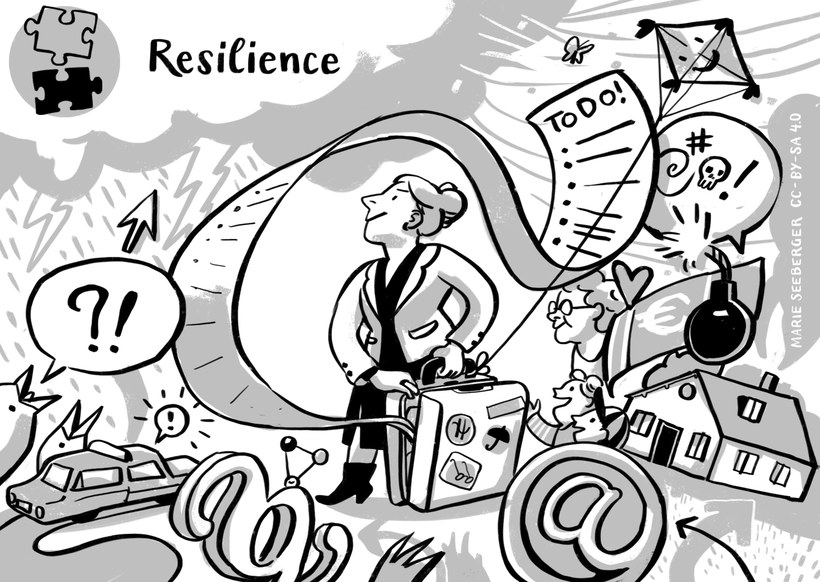
Meaning
The original meaning of Resilience refers to the ability of material such as rubber to spring back to its original shape after deformation. In our changing world the term is generally used for the ability and quality that enable people who have been knocked down by adversities, suffer from set-backs or negative emotions to recover, adapt to the challenging circumstances and to bounce back being as strong as before and at time even stronger. Rather than letting issues and problems overcome you, high resilient people find a way to change course and continue moving forward towards their goals and learn that making mistakes is fine as long as they take them as a way of learning and personal development.
Example
Elisabeth is in charge of task coordination and disappointed because two members of their team are not well prepared for the meeting. Because this happened before, she lets go of her frustration. The team decides to adjourn the meeting in order for the two to catch up. Elisabeth airs her view that she is upset because her time is not being respected but at the same time wants a constructive solution to the issue. By voicing the issue in a friendly manner, Elisabeth makes herself understood. She is glad that the ill-prepared team members not only acknowledge her view but show appreciation of the team being flexible enough to allow them to catch up. Looking back at it she strongly feels that this incidence strengthened their team identity and the mutual adjustment highlights their resilience as a team.
Activity: Reflecting on positive and negative experiences
Positive emotions can apparently help you strengthen your resilience. For the next couple of days carry out the following activity:
In the evening, before calling it a day, sit down and note down three good things you encountered during the day. Think about one experience which dragged you down or upset you and write it down as well. Note how you felt and the frustration which went along with it. But rather than focusing on the frustrations, think about two things which could also be interpreted as positive. What was a good thing about the experience?

Meaning
Instead of dwelling on issues and their negative impacts, on one’s mood or frustrations, seeking options for action refers to an attitude of accepting unsettling and at times also ambiguous situations as a normal part of working life. It also refers to a general openness towards diversity and the ability to see diversity as a benefit and potential strength of a team. Diversity in this respect also includes diversity of tools, touch points, communication situations and the like Thus seeking for alternative options refers to the readiness of accepting variety, change and stimulation.
Example
Hülya recently started to work for an organisation specialised in providing psycho-social-support in a home for refugees. During the Corona pandemic some of her colleagues from a team of about thirty members had to suddenly work from home (for health reasons) or in shifts which caused some major challenges. The technical situation was difficult as only some were equipped with official mobiles and computers and cameras were in short supply. This made hybrid team meetings were difficult to conduct. As a consequence, communication flow within the team dwindled and was reduced more and more.
Hülya more or less only talked to her mentor at the beginning of her work. And it was the same with the residents she was expected to take care of. How could she get in touch with her clients who came from all over the world and were now confined to stay inside their rooms following contact and hygiene rules. How could she build up a personal relationship as no one knew her? And she surely had other expectations with regard to her on-boarding into her new job.
Finally, Hülya encouraged herself to ask some of the (mostly unknown) team members to meet with her (some virtually / some in person) to get advice. Also a collaborative whiteboard as well as a flipchart paper were installed with her questions to the team so that all could note down their tips. Her colleagues brainstormed and came up with many brilliant ideas for Hülya. These included the use of bulletins with pictures and easy language which were translated in many languages. They contained information about the task and service and where and when to find her. They motivated Hülya to bring along sweets as presents for the kids when meeting them for the first time. Another idea was to play different types of music outside of the home to get attention and wait for visitors to come by and talk to her.
She decided to use many of the ideas and included a playlist in her bulletin with the hours of music to be played from around the world. Her mentor introduced her to one of the networking persons in the group of residents and bit by bit she made contacts, established relationships and could start her important psycho-social support work for the refugees.
Activity: Developing the communication flow within the team
As Hülya suffers from the missing communication flow in the team she decides to think about collecting ideas for fostering the team's communication flow. Put yourself in the shoes of Hülya. What would you think of in a context in which people have no or very limited opportunities to meet face to face and a not enough technical device to strengthen the communication flow? Note down your ideas in your learning journal.
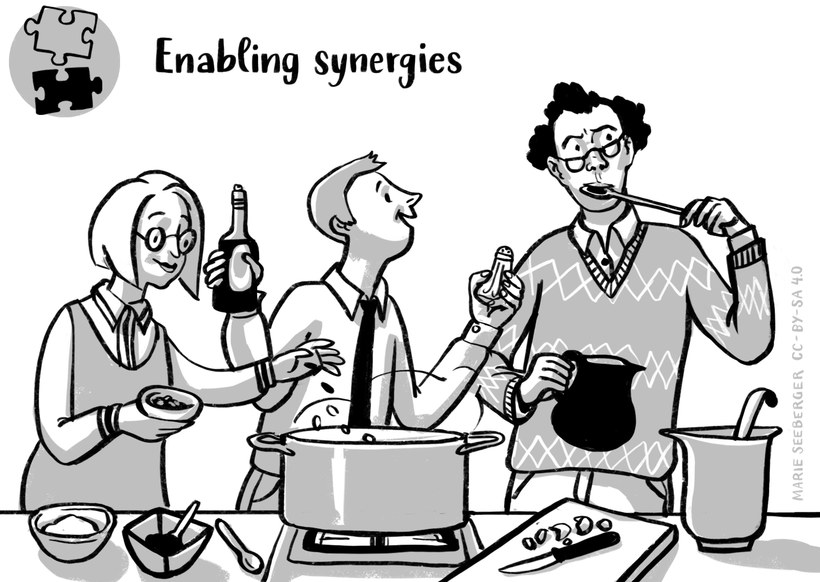
Meaning
A wonderful image of synergy can be found in nature watching the migration of geese. They get together and fly in a V-shape formation in order to minimise wind resistance for the birds following. When the bird in front gets tired, another one takes the lead. Together they can fly a lot further using less energy than they would if each of them would fly on its own. Even more so in case a goose would fly on its own trying to cover the distance, it is doomed to fail.
Enabling synergies requires to be sensitive to the needs of the team, to ensure that different perspectives are actively thought for well, understood and used in problem solving situations. It is the belief that a team works at its best when is acting together and trust that joint or coordinated effort achieve a greater impact and efficiency than each team member working on his or her own. In such environment ideas can spring up and solutions can be found which hitherto were not thinkable.
Sources of synergies often revolve around cost savings for example through access to new researches and developments which allow for an advancement in production, or software teams that yield cost savings. More generally speaking enabling synergies relates to the combined effort and action when different individuals team up and collaborate in developing new solutions that improve the result by sharing of perceptions, insights and knowledge. Enabling synergies is a complex task and not easy but worth the effort as it is the basis for teams to outperform and develop a high team satisfaction.
Example
One way of enabling synergy effects is by complementing talents and expertise as is often expected from project teams. The Blundy team is an example. Whereas Yuki is very strong in engineering and manufacturing, she finds it difficult to communicate. Olusio however is very good at internal as well as external communication and Pete is being appreciated for his strength in finance. To complement their project team, they are looking for a member bringing in expertise in marketing and advertising.
Timo and his team are an example where synergies came into being due to cognitive stimulation. Timo was more the person thinking that working on his own saves time and effort to liaise with others, explain oneself as well as dealing with team related issues. But when he was offered a new job as a business consultant one of the precondition was to work in a virtual interdisciplinary team. Thinking back at the achievements they made in their virtual team he was glad that he got passed himself and able to view the opportunities available in his team. Right from the onset, he felt welcomed and his views and knowledge being appreciated. He started to trust his team members and felt confident to rely on others. But most importantly he realised that they were able to benefit from the diverse knowledge and experiences as well as their different characteristics. While Pierre was the one who brought in ideas and proved to be very spontaneous implementing them, Timo realised that he was truly trained to be very particular, collecting a lot of information before making a proposal and engaged in deep thinking before putting an idea forward to their client. Aruba, was quite different again and very strong at considering different perspectives and the pros and cons of different approaches. Because they got on really well and all eager to achieve a good result, they were not only able to provide an expert advice which fitted their clients’ situation but also level headed and innovative.
Activity: Synergies through differences
Go back to the exercise of the common triangle in session 5, section 5.5 (Creating mutuality in intercultural and interdisciplinary virtual teams). Choose two areas where you detected differences. Looking back at these, which potentials for synergies do they entail and how could synergies look like? Note down the results in your learning journal.
